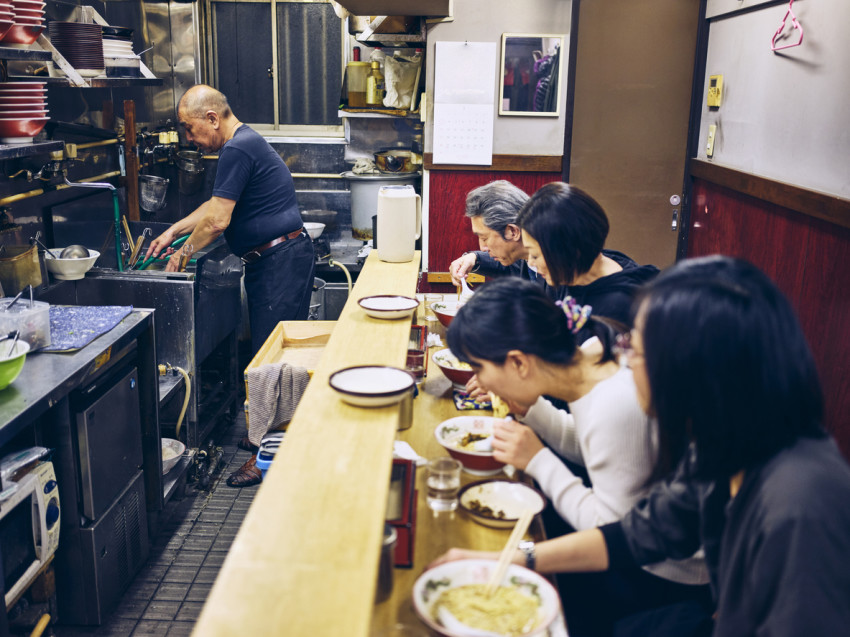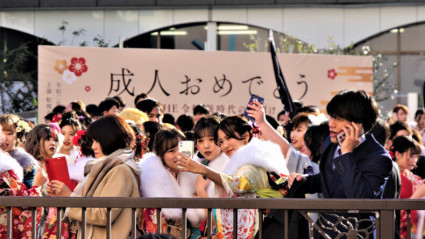A record number of ramen noodle eatery operators in Japan went out of business in 2024, according to a research firm, as the food's reputation for affordability limits room to raise prices amid soaring ingredient and utility costs.
Also hit by climbing personnel expenses due to labor shortages, insolvencies among ramen business operators resulting in liabilities of at least 10 million yen in 2024 jumped over 30 percent to 72, up from 53 in 2023, Teikoku Databank Ltd said.
Japanese ramen soup noodles typically combine meat and vegetable toppings with broth. Despite rising costs, the average price of a bowl of ramen is still under 700 yen, according to Teikoku Databank. A popular lunchtime staple or late-night guilty pleasure, ramen has also found fans overseas.
But with 2024 ingredient costs as of October up by an average of over 10 percent from 2022, businesses face having to bring prices closer to 1,000 yen. Though low compared with many dining options, crossing that line is seen as a blow to ramen's everyman image that could drive away diners.
Takatoyo Sato, manager of noodle eatery Menkoi Dokoro Kiraku in the capital's Shimbashi business district, said he last upped prices in May 2024 in response to tightening business conditions. Most popular among his local clientele is its shoyu ramen with soy sauce-based broth for 950 yen, up from 780 yen in 2021.
"I couldn't hesitate in raising prices, otherwise we'd have been in the red," the 52-year-old said on a break between lunch and dinner service during one of the 17-hour shifts he works six days a week.
Nearly 34 percent of the around 350 ramen eatery businesses surveyed by Teikoku Databank reported that they were running at a loss in fiscal 2023.
Sato said the decision had not been received well by all his regulars. "Custom definitely fell after. People don't say it, but they think it's just ramen -- that view is going to change," he said, referring to the rising costs of serving up the familiar comfort food.
Some consumers are shifting their perceptions. Munayoshi Suzuki, a 34-year-old Tokyo resident, said he thinks diners have been "spoiled" by low prices, and the food is a "non-necessity" more akin to cigarettes or alcohol.
Into 2025, Teikoku Databank says bankruptcies could continue, with small and medium-sized businesses likely to be more reluctant than larger chains to revise their menu prices.
Sato, too, says he does not think customers can be convinced to pay more just yet. "We'll just pray costs don't go up further this year."
© KYODO















16 Comments
Login to comment
sakurasuki
Is not about labor shortage, is all about that business establishment unwilling to give increase wages to their employee or part timer.
Newgirlintown
Prices are going up but people’s pay isn’t. That’s the problem.
sakurasuki
What JGovt has done about it?
itsonlyrocknroll
1000 JPY aprox 5.16 GBP...
London December, a posh Burger Chips 24.50 GBP/4,721.02 JPY
Big bowl Ramen at my local is 760 JPY.
Lindsay
Considering there is a ramen shop on every corner and three more in between and the cost of living increasing with no salary increases for decades it should be no surprise that many small businesses are failing.
nakanoguy01
Ah Kyodo, you always bring a smile to my face with your writings. How about just "ramen shops"?
Anyway, Japanese people need to get out of their deflationary mindset. It's wishful thinking that prices will always be the same or even go down from here on out. Inflation is actually a good thing in the long run.
Fighto!
I'm surprised the article does not mention the fact that people are choosing to eat less unhealthy food compared to the past. Ramen typically has a big amount of sodium. Alcohol consumption is also down everywhere, also partially for health reasons.
Plus, I'd imagine the elderly eat less ramen than when they were young?
Bret T
Sad news. No doubt many hard-working couples who have been operating ramen shops for decades and know no other way of making a living.
Peter Neil
remember the old japanese investment shows, later copied by shark tank et al?
every other business plan was a new ramen shop and the judges had to taste them constantly. haha.
if your pricing is in the middle, you're the most vulnerable. you have choose high or low. shrinkflation may be better than cheaper ingredients or cutting corners.
this is funny. there's a chinese takeout place near me that buys frozen dinners and appetizers from costco in bulk and makes everything in microwaves lined up in the back and puts it in cardboard containers.
the only thing they make is a big pot of cheap rice. most customers don't even know it. :)
wallace
The ramen price barrier is ¥1,000 but some places now charge ¥1,500 not a price some want to pay.
bass4funk
I’m so glad Fukuoka doesn’t have this problem on that scale like they do up north, the industry is thriving and thriving hard. But you just can’t beat Hakata tonkotsu ramen.
koiwaicoffee
Average salary in London (no refinements, just asked Google)
£47,455, some 9 million yen
Hiro
It's not just the ingredients, energy costs are also way up. The higher cost mostly reflects the weak yen.
koiwaicoffee
But yeah, prices have gone up around a 30% on everything, but salaries are about the same. You can notice that people is concerned and don't have an extra for eating out, even ramen.
virusrex
This is the part that is difficult to understand, people happily pay well over 1000 yen for other kind of food (lunch sets, pasta, etc.) but ramen is seen as something that must be cheap no matter what, the big amount of ramen shops mean it has also to be really good to remain competitive so the situation has no solution. For other food options people can understand they will have to choose between "cheap but lower quality" and "really good but paying more" but strangely this never applies to ramen.
wallace
London rents and house prices are more than twice that of Tokyo.
You would need around 1,332,983.1¥ (6,793.1£) in London to maintain the same standard of life that you can have with 740,000.0¥ in Tokyo
https://www.numbeo.com/cost-of-living/compare_cities.jsp?country1=Japan&city1=Tokyo&country2=United+Kingdom&city2=London#:~:text=You%20would%20need%20around%201%2C332%2C983.1,earnings%20(after%20income%20tax).
otherworldly
There are too many ramen shops in Tokyo. The cream always rises to the top, but the good ones will always be there.
John-San
Since inflation rice is on the uptake. More people eating rice less eating noodles. So I assume with what fighto suggested and rice a healthier option is the main reason. I don't think more people are eating at home, I think they looking at filling their bellies a cheaper way. compare the 800 yen ramen to a 650 yen gyudon and rice set or a kare and rice set. I suggest you get more distance out of the gyudon / kare and rice set for less money.